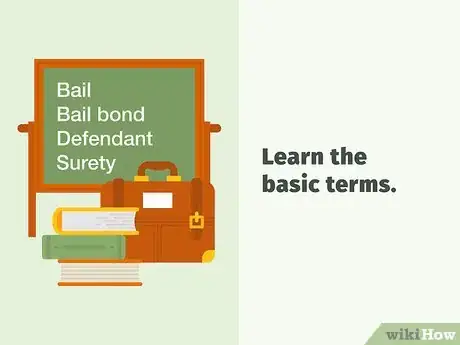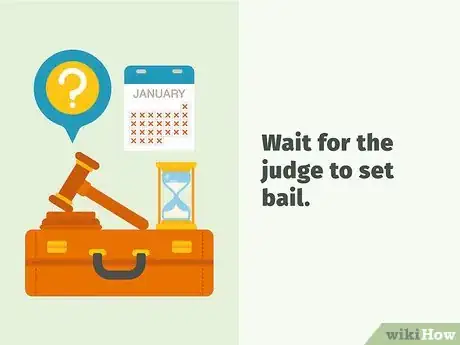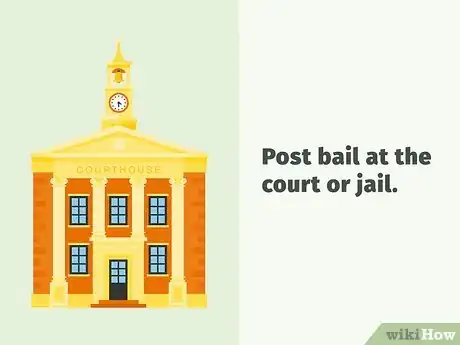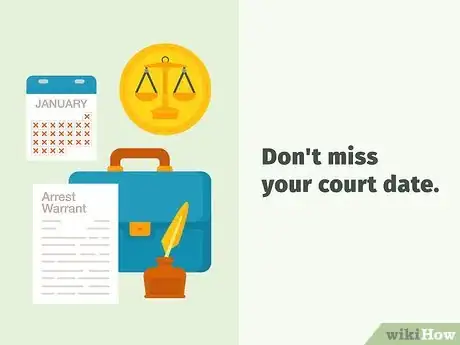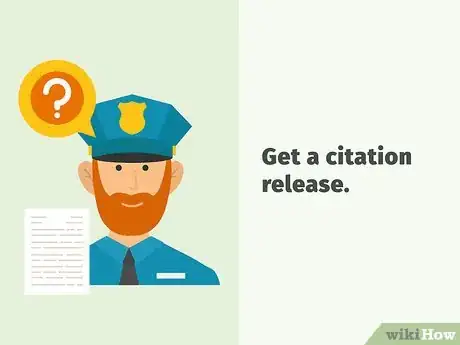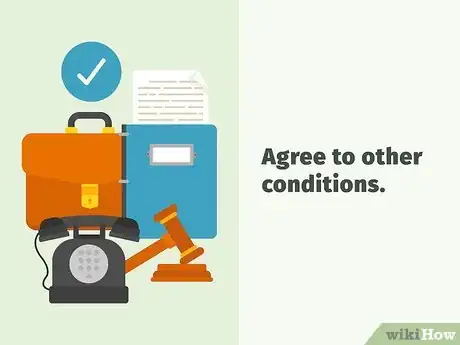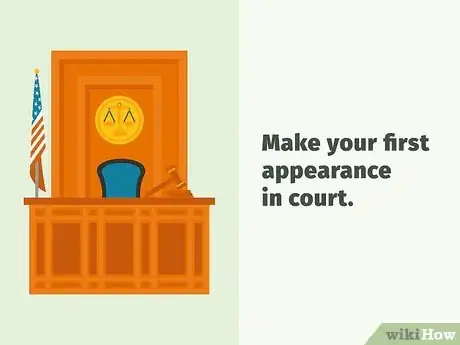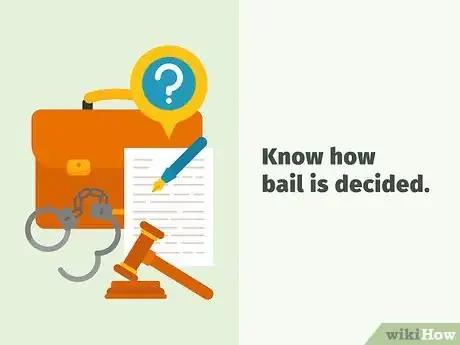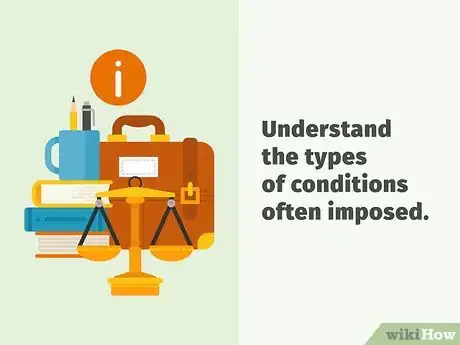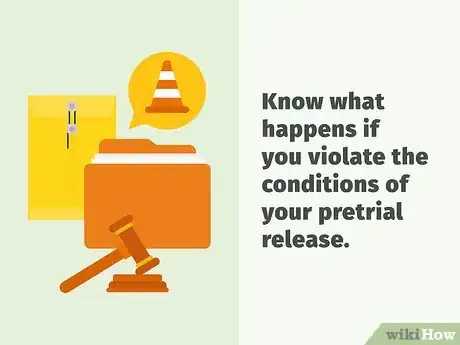This article was co-authored by Clinton M. Sandvick, JD, PhD. Clinton M. Sandvick worked as a civil litigator in California for over 7 years. He received his JD from the University of Wisconsin-Madison in 1998 and his PhD in American History from the University of Oregon in 2013.
There are 13 references cited in this article, which can be found at the bottom of the page.
This article has been viewed 168,478 times.
Each state has its own bail bond system, which gives someone who has been charged with a crime the opportunity to get out of jail and remain out until they go to trial. Different states provide different types of bail options, but the main principles are the same in every system. If you have been charged with a crime, or are considering posting bail for someone else, learning how different bail bond systems work can help you obtain freedom for yourself or someone close to you.
Steps
Understanding Bail Basics
-
1Learn the basic terms. Bail is money or other property deposited with or promised to a court to persuade the judge to release a defendant from jail, with the understanding that the defendant will return to court for the trial. A "bail bond" refers to the promise made by the defendant or a "surety" (someone who promises to pay for the defendant) to the court to forfeit the bail money if the defendant does not return.[1] A surety can be a professional bail bond agent, or a friend or family member.[2]
-
2Wait for the judge to set bail. The purpose of setting bail is to ensure that the defendant appears at trial without necessarily having to keep the defendant in custody. The bail amount needs to be significantly high enough so that the defendant will not simply forfeit the bail amount and disappear. Many courts have preset bail amounts for each offense, though a judge can deviate from those guidelines for good cause.[3]
- For example, this Los Angeles County Felony Bail Schedule recommends bail of $50,000 for campaign violations, and $100,000 for kidnapping.
- A judge can decide not to allow the defendant to be released on bail if the defendant is a flight risk (not likely to return to court for trial), or a danger to the community.[4] Defendants are less likely to be considered a flight risk when they have family and community ties to the area, employment, minimal criminal history, or a record of appearing as required in the past.[5]
Advertisement -
3Post bail at the court or jail. After the judge has set a bail amount during a court hearing, defendants and sureties can post bail with the court clerk during regular business hours, or at the jail after hours. The court or jail will issue a receipt for the bail bond, proving that bail was posted.
-
4Don't miss your court date. If the defendant does not return to return to court as required, the court will schedule a forfeiture hearing and issue an arrest warrant. The defendant will have an opportunity to explain why he or she missed the court date, such as a misunderstanding or unavoidable delay. If the defendant fails to appear for the forfeiture hearing or does not have a valid excuse, the court will keep the bond amount.
-
5Consider signing with a professional bail agent. Bail agents, sometimes called bail bondsmen, act as sureties and post bail on behalf of defendants. A bail agent makes a profit by charging the defendant a non-refundable fee (usually 10% of the bail amount). If the defendant fails to appear in court, the bail agent forfeits the bond amount. The agent is also authorized to arrest the defendant for the purposes of bringing him or her to court. In some states, the agent can hire a bounty hunter to apprehend the defendant.[6] The agent may also bring a civil suit against the defendant or anyone else obligated under the bail agent's contract to recover the bail money the agent paid to the court.
- Posting bail for profit is prohibited in Oregon, Nebraska, Wisconsin, Illinois, Kentucky, and Maine, which makes it illegal for professional bail agents to operate. These states are more likely to allow a defendant or surety to post a percentage of the total bail amount instead of the entire total.[7]
- In these states, if you fail to appear in court when required to do so, you will be arrested by the police or the sheriff's department as opposed to being seized by a bounty hunter.
- Posting bail for profit is prohibited in Oregon, Nebraska, Wisconsin, Illinois, Kentucky, and Maine, which makes it illegal for professional bail agents to operate. These states are more likely to allow a defendant or surety to post a percentage of the total bail amount instead of the entire total.[7]
Comparing Bonds Requiring Payment
-
1Post a cash bond. With a cash bond, the judge requires that the defendant or a surety deposit the entire bail amount in cash. The money is held until the case is concluded, and is refunded to the person who posted it. If the defendant posts his or her own cash bond, the court may deduct any fines and costs before returning the money.
- Cash bonds requiring that the entire bail amount be posted up front are more stringent than percentage bonds, which only require a percentage of the bail amount. The full amount is typically required where the defendant is a flight risk, has outstanding unpaid fines, or has failed to return to court before. Percentage bonds are common in states where professional bail agents cannot operate.
-
2Post a percentage bond. With a percentage bond, the judge sets a bail amount, then requires that the defendant or surety deposit only a percentage (typically 10%) of the total bail amount up front, and agrees to pay the remainder if the defendant fails to appear in court.[8]
-
3Get an immigration bond. Immigration bonds operate through federal law, rather than state law. A surety may be able to post a bond for a defendant who is an undocumented immigrant detained within the United States. If the defendant misses his or her court date, the surety has the opportunity to deliver the defendant to court to regain a percentage of the bond. If the defendant is returned within 10 days of the missed court date, the surety can recover 66.67% of the bond. 50% is returned within 20 days, and 30% is returned within 30 days. After 30 days, the surety cannot recover any percentage of the bond.[9]
-
4Post a property bond. In some jurisdictions, the defendant or surety can post bail by pledging real property (such as a house) worth at least the value of the bail amount. If the defendant fails to appear, the court can levy or foreclose on the property. If the property has multiple owners on title, all owners must sign the bail bond. The court may also require proof of ownership and proof of the value of the property, such as an appraisal by a local real estate agent.[10]
Comparing Bonds and Alternatives Not Requiring Payment
-
1Get "released on own recognizance" (ROR). For an ROR, the judge can release the defendant upon the condition that the defendant continue to appear in court. The judge may also impose other conditions, such as requiring the defendant to stay in the local geographic area or contact the court regularly to check in.[11]
-
2Sign an unsecured appearance bond. With an unsecured appearance bond, the defendant is released upon his or her promise to appear in court. The defendant can be ordered to pay a specific sum of money to the court if he or she fails to appear.
-
3Get a citation release. For some minor offenses, an arresting officer will issue a citation to an arrested person which requires him or her to appear in court.[12] The arrested person is not taken into custody, and no bail amount is collected. Failing to appear can result in additional fines, charges, and an arrest warrant.[13]
-
4Agree to other conditions. A judge can impose conditions in addition to bail arrangement, such as giving a DNA sample, phone or in-person check-ins, drug testing, court date reminders, etc.
Being Released in Federal Court
-
1Make your first appearance in court. In federal court, your first court appearance will be with a federal magistrate who will inform you of the charges against you and who will decide if you should be released pending trial.[14] Prior to your first hearing, a Pretrial Services Officer will speak with you and as many of your family members as possible.[15] Their job is to gather information about your background and personal circumstances and file a report to the court.[16] The report will make recommendations to the judge and prosecutor about whether you should be released pending trial and if so, if any conditions should be attached to your release.[17]
-
2Know how bail is decided. Unlike state court, federal courts do not have fixed bail amounts.[18] In federal court, the magistrate will release you with conditions sufficient to ensure you continue to come to court when required.[19]
- Bail bondsmen are rarely used in federal court, and for low income defendants, there is usually no cash component to your federal bail.[20]
- In federal court, you are basically entering into a contract between yourself, any co-signers, and the government.[21] If you do not show up, you will have breached the contract and consequences will follow.[22]
-
3Understand the types of conditions often imposed. Each case will differ and the types of conditions that are placed on your release will depend on the seriousness of the crime you are alleged to have committed, your criminal history, your ties to the community, and your financial circumstances.[25] In general the following types of conditions are common:
- Pretrial supervision;
- Drug testing;
- Mental health evaluations;
- Travel restrictions;
- Surrender of travel documents (e.g., passports);
- Electronic monitoring; and
- Curfews.[26]
-
4Know what happens if you violate the conditions of you pretrial release. If you fail to appear at a required hearing, the court may rescind your bail and may issue a warrant for your arrest.[27] At that point, federal marshals will be responsible for finding and returning you to jail.
References
- ↑ http://legal-dictionary.thefreedictionary.com/Bail+bond
- ↑ http://legal-dictionary.thefreedictionary.com/Bail+bond
- ↑ http://legal-dictionary.thefreedictionary.com/Bail+schedule
- ↑ https://www.law.cornell.edu/uscode/text/18/3142
- ↑ http://www.nolo.com/legal-encyclopedia/bail-getting-out-of-jail-30225.html
- ↑ http://www.bailbondinformationcenter.com/How-Do-Bail-Bonds-Work.php
- ↑ https://www.lawyers.com/legal-info/criminal/criminal-law-basics/posting-bail-what-are-your-options.html
- ↑ http://www.lccpa.org/forms/criminal/bail/BailGuidelines-publicweb.pdf
- ↑ https://www.ilw.com/forms/i-352fillable.pdf
- ↑ https://www.paed.uscourts.gov/documents/handbook/forms/app_w.pdf
- ↑ http://criminal.findlaw.com/criminal-procedure/own-recognizance-release.html
- ↑ http://www.pretrial.org/solutions/citation/
- ↑ http://www.legalmatch.com/law-library/article/failure-to-appear-in-court.html
- ↑ http://federaldefendersny.org/information-for-client-and-families/bond-and-pretrial-detention-faqs.html
- ↑ http://federaldefendersny.org/information-for-client-and-families/bond-and-pretrial-detention-faqs.html
- ↑ http://federaldefendersny.org/information-for-client-and-families/bond-and-pretrial-detention-faqs.html
- ↑ http://federaldefendersny.org/information-for-client-and-families/bond-and-pretrial-detention-faqs.html
- ↑ http://federaldefendersny.org/information-for-client-and-families/bond-and-pretrial-detention-faqs.html
- ↑ http://federaldefendersny.org/information-for-client-and-families/bond-and-pretrial-detention-faqs.html
- ↑ http://federaldefendersny.org/information-for-client-and-families/bond-and-pretrial-detention-faqs.html
- ↑ http://federaldefendersny.org/information-for-client-and-families/bond-and-pretrial-detention-faqs.html
- ↑ http://federaldefendersny.org/information-for-client-and-families/bond-and-pretrial-detention-faqs.html
- ↑ http://federaldefendersny.org/information-for-client-and-families/bond-and-pretrial-detention-faqs.html
- ↑ http://federaldefendersny.org/information-for-client-and-families/bond-and-pretrial-detention-faqs.html
- ↑ http://federaldefendersny.org/information-for-client-and-families/bond-and-pretrial-detention-faqs.html
- ↑ http://federaldefendersny.org/information-for-client-and-families/bond-and-pretrial-detention-faqs.html
- ↑ http://federaldefendersny.org/information-for-client-and-families/bond-and-pretrial-detention-faqs.html
About This Article
To understand how bail bonds work, understand that bail is money or property given to a court in exchange for the release of a defendant from jail before their trial date. If the defendant doesn't show up for their trial, the money or property is forfeited, which creates an incentive for the defendant to not disappear before their trial date. Bail can be posted by the defendant themselves, or it can be posted by someone else, like a friend or family member. For more tips from our Legal co-author, like how to post bond, scroll down!
